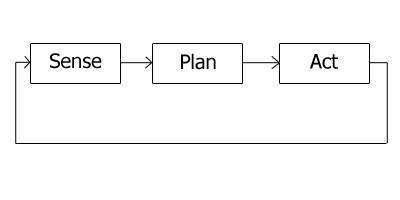Top Qs
Timeline
Chat
Perspective
Robotic paradigm
From Wikipedia, the free encyclopedia
Remove ads
In robotics, a robotic paradigm is a mental model of how a robot operates. A robotic paradigm can be described by the relationship between the three basic elements of robotics: Sensing, Planning, and Acting. It can also be described by how sensory data is processed and distributed through the system, and where decisions are made.
This article has multiple issues. Please help improve it or discuss these issues on the talk page. (Learn how and when to remove these messages)
|
Remove ads
Hierarchical/deliberative paradigm
The hierarchical or deliberative paradigm describes a top-down control structure in which the robot's actions are driven by explicit planning. The robot follows a sense-plan-act sequence. At each step, it collects sensory information, updates an internal model of the world and determines the next action based on the model.
- The robot operates in a top-down fashion, heavy on planning.
- The robot senses the world, plans the next action, acts; at each step the robot explicitly plans the next move.
- All the sensing data tends to be gathered into one global world model.

Remove ads
The reactive paradigm
The reactive paradigm describes a bottom-up control structure in which the robot's actions emerge form direct interactions between the robots senors and behaviours, without relying on a central plan or world model.
- Sense-act type of coupling.
- The robot can have multiple instances of Sense-Act couplings.
- These couplings are concurrent processes, called behaviours, which take the local sensing data and compute the best action to take independently of what the other processes are doing.
- The robot will do a combination of behaviours.

Remove ads
Hybrid deliberate/reactive paradigm
The hybrid paradigm combines elements of both the behaviours and reactive approaches. The robot first plans (deliberates) how to decompose a task into smaller subtasks and selects suitable behaviours to accomplish each one. Once planning is complete, these behaviours execute concurrently following the reactive paradigm.
- The robot first plans (deliberates) how to best decompose a task into subtasks (also called “mission planning”) and then what are the suitable behaviours to accomplish each subtask.
- Then the behaviours starts executing as per the Reactive Paradigm.
- Sensing organization is also a mixture of Hierarchical and Reactive styles; sensor data gets routed to each behaviour that needs that sensor, but is also available to the planner for construction of a task-oriented global world model.

See also
References
- Asada, H. & Slotine, J.-J. E. (1986). Robot Analysis and Control. Wiley. ISBN 0-471-83029-1.
- Arkin, Ronald C. (1998). Behavior-Based Robotics. MIT Press. ISBN 0-262-01165-4.
Wikiwand - on
Seamless Wikipedia browsing. On steroids.
Remove ads